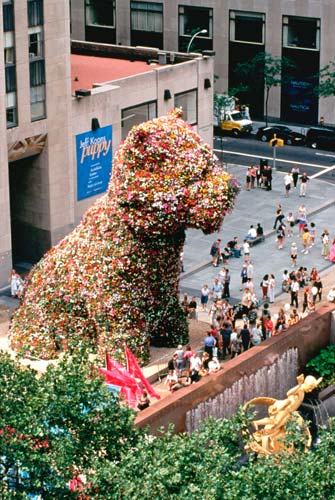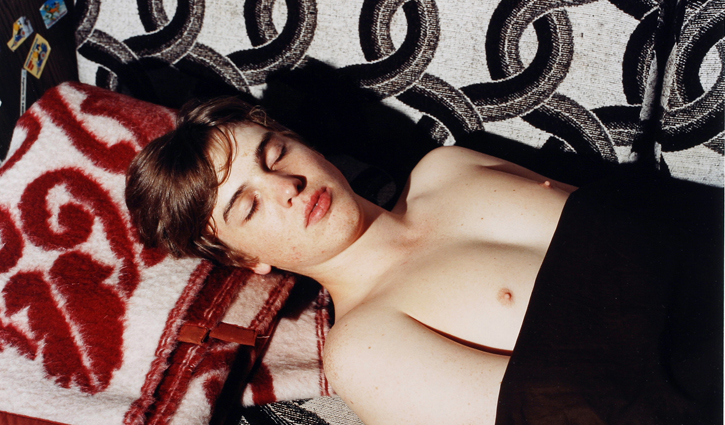Looking back before moving forward is such an endearing habit—like brushing your teeth before breakfast—that it’s hard to resent the sweeping, often grandiloquent judgments that accompany the end of each year (last year, when Daniel Birnbaum called a documentary by Alexander Kluge “a labyrinth as absorbing as any great cultural work of the past century,” I was more than willing to embrace the hyperbolic praise as truth). But now, at the close of a decade in which art often moonlighted as a history project and calculated reticence often seemed more provocative than raw expression, looking back seems especially difficult because looking back is what much of the decade’s art tried to do.
Charged with the thorny task of reviewing ten years’ worth of art, critic Jerry Saltz came up with a strange combination of showmanship and doom. Writing in New York Magazine, he pinpointed Jeff Koons‘s towering, endearingly overstuffed Puppy (the version that debuted at Rockefeller Center in June 2000) as the decade’s turning point, “an artifact from the last days of ‘the end of history.’” Appearing a year before 9/11, Koons’s sculpture was an over-ambitious attempt to make guilelessness monumental. It embodied a lighthearted moment of spectacle that would begin to lose its footing (even though as it continued to hold its own in art markets). Puppy, according to Saltz, “laid a beautiful, ghastly laurel wreath at our doorstep. If it could speak, it would say, ‘After me, the deluge.’”
But if Koons’s flower-coated monster represented the end of a certain kind of spectacle (and I think Saltz is right in suggesting that it did, though misguided, perhaps, in the esteem he awards it), then it’s the art that came after Puppy that deserves attention. The decade should belong to artists who saw the supposed deluge as a reason to stop trying to make history and start rephrasing, breaking apart, and rearranging their cultural heritage, freeing repressed fragments of meaning in hopes of informing an unknown future.
Collier Schorr’s Jens F. project still stands out to me as an eloquent example of this sort of rephrasing. Schorr (Season 2) restaged Andrew Wyeth’s portraits of his muse Helga, placing an adolescent boy in feminine poses, subtly turning his body in ways that seemed difficult and unnatural. She treated appropriation, not as something transgressive, but as something tenderly introspective and revealing. Another example, Elad Lassry’s self-described post-picture generation work, is fugitive in that it liberally borrows from commercial iconography. But it’s professional in its sleek, minimal distillation of the ideologies latent in each image. For Lassry and for Schorr, wading through our lineage of cultural imagery isn’t just a prerequisite to moving forward; it’s actually a way of interacting with present and future.
Fittingly enough, Los Angeles has ended the decade with its galleries and museums brimming with art that looks back. At LACMA, a whole exhibition of landscape photography from 1975—New Topographics—has been rephrased. The motivation: simply acknowledging art’s “ongoing concern for man’s use of the land.” On the second floor of Steve Turner Contemporary, Amir Zaki collected antique images, spanning from 1870-1950, of Southern California’s evolution, curating a mini-visual history. At Blum & Poe, Drew Heitzler has remixed films from the ‘60s, removing the narrative arc in order to emphasize strange movements and interactions that plot once repressed.
One of the most resonant exhibitions I’ve seen, however, branches away from image-driven rephrasals of history. Kristen Morgin’s Cellos, clay sculptures currently on view at Marc Selwyn Fine Art, are pragmatic, systematic, and yet unnervingly visceral. Built onto wood and wire armatures, the Cellos give the illusion of being exquisitely accurate and proportionate. They are arranged in rows, like museum specimens, and they occupy a dimly lit room. The dry, unfired clay gives the surface of each instrument a rough texture and each instrument evidences a different stage of disintegration. It’s as if Morgin took one delicate, aging artifact and remade it again and again to see how far she could push before it dissipated completely, leaving only residue. It never does decay, however—at least, not entirely–and its presence in the gallery seems to ensure its preservation, even if only as a metaphor for what art might look like over time.








Pingback: What’s Cookin at the Art21 Blog: A Weekly Index | Art21 Blog